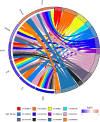Effective Components of Panax notoginseng- Salvia miltiorrhiza in the Treatment of Melasma and Its Experimental Study
- PMID: 39895736
- PMCID: PMC11780428
- DOI: 10.1021/acsomega.4c09799
Effective Components of Panax notoginseng- Salvia miltiorrhiza in the Treatment of Melasma and Its Experimental Study
Abstract
Purpose: The main purpose of this study was to predict and verify the active ingredients of Panax notoginseng-Salvia miltiorrhiza in melasma based on network pharmacology analysis and experimental verification.
Materials and methods: Panax notoginseng-Salviae miltiorrhizae was investigated by network pharmacology, GEO database analysis, and molecular docking techniques to screen its active ingredients. The active components of Panax notoginseng-Salviae miltiorrhizae were further validated by an in vitro α-melanin-induced B16F10 melanoma cell model and an in vivo UV irradiation combined with a progesterone injection-induced melasma rat model.
Results: Network pharmacology analysis and molecular docking showed that salvianolic acid B might be the key active ingredient. In vitro cellular experiments revealed that salvianolic acid B inhibits tyrosinase activity in B16F10 cells at concentrations of 60-90 nmol/mL. In vivo animal experiments found that TYR, MDA, and TNF-α were decreased in the skin and serum of rats in the group of the low-, medium-, and high-dose groups of salvianolic acid B, and the expression of GSH-Px and SOD was increased. The high-dose groups of salvianolic acid B showed the best therapeutic effect.
Conclusion: In this study, experiments collectively show that salvianolic acid B in Panax notoginseng-Salvia miltiorrhiza slows down the process of melasma by inhibiting lipid peroxidation in the organism, increasing the antioxidant capacity of the skin, decreasing the activity of tyrosinase, and providing anti-inflammation. This highlights the successful application of network pharmacology and provides a scientific basis for the clinical citation of Panax notoginseng-Salvia miltiorrhiza in treating melasma.
© 2025 The Authors. Published by American Chemical Society.
Conflict of interest statement
The authors declare no competing financial interest.
Figures










Similar articles
-
Network Pharmacology-Based Dissection of the Active Ingredients and Protective Mechanism of the Salvia Miltiorrhiza and Panax Notoginseng Herb Pair against Insulin Resistance.ACS Omega. 2021 Jun 30;6(27):17276-17288. doi: 10.1021/acsomega.1c01209. eCollection 2021 Jul 13. ACS Omega. 2021. PMID: 34278114 Free PMC article.
-
[Observation of therapeutic effect by combined administration of Salvia miltiorrhiza, ligustrazine and Panax notoginseng on late hemorrhagic shock of rabbits].Zhongguo Zhong Xi Yi Jie He Za Zhi. 1997 May;17(5):292-4. Zhongguo Zhong Xi Yi Jie He Za Zhi. 1997. PMID: 9863115 Chinese.
-
A HPLC-DAD-MS/MS Method for Simultaneous Determination of Six Active Ingredients of Salviae Miltiorrhizae and Ligustrazine Hydrochloride Injection in Rat Plasma and its Application to Pharmacokinetic Studies.Curr Drug Metab. 2021;22(1):60-69. doi: 10.2174/1389200221999200819143230. Curr Drug Metab. 2021. PMID: 32819255
-
Anti-atherosclerotic effects and molecular targets of salvianolic acids from Salvia miltiorrhiza Bunge.Front Pharmacol. 2025 May 21;16:1574086. doi: 10.3389/fphar.2025.1574086. eCollection 2025. Front Pharmacol. 2025. PMID: 40469984 Free PMC article. Review.
-
[Modernization of Chinese medicine Salviae Miltiorrhizae Radix et Rhizoma: a review].Zhongguo Zhong Yao Za Zhi. 2022 Oct;47(19):5131-5139. doi: 10.19540/j.cnki.cjcmm.20220808.101. Zhongguo Zhong Yao Za Zhi. 2022. PMID: 36472020 Review. Chinese.
References
-
- Shike S.; Yudi Z.; Rongheng L. Blood rheology and clinical. Modern Medical J. 2017, 45 (1), 163–167.
- Lin X. Y.; Zhou G. P.; Li L. A preliminary analysis of serum enzymes and hemorrheology for chloasma in female patients. J. Clin. Dermatol. 1997, (6), 359–361.
LinkOut - more resources
Full Text Sources
